Recommendations sought for holding forstner bits while drilling out vases? Any thoughts appreciated, THANKS.
-
November 2025 Turning Challenge: Wall Hanging! (click here for details) -
Sign up for the 2025 AAW Forum Holiday Swap by Monday, November 24th (click here for details) -
Congratulations to Tracey Lee for "Huggins with Rope" being selected as Turning of the Week for November 10, 2025 (click here for details) -
Welcome new registering member. Your username must be your real First and Last name (for example: John Doe). "Screen names" and "handles" are not allowed and your registration will be deleted if you don't use your real name. Also, do not use all caps nor all lower case.
You are using an out of date browser. It may not display this or other websites correctly.
You should upgrade or use an alternative browser.
You should upgrade or use an alternative browser.
Drill Chucks...
- Thread starter John Grace
- Start date
Mark Hepburn
Artist & Chef
If you use a keyed chuck you can use the round end of the handle in one of the 3 holes let the other end slide along a tool rest to prevent the morse taper from loosening and spinning. This will prevent damage to the taper bore and also can be used as a handle when retracting the bit from the hole,especially if you don't clear the chipps often enough.
See Packard Woodworks catalog, Item number 111011, Arbor key chuck. I have a YouTube video on how to secure it in the tailstock for drilling. I put a pin in it to prevent it from coming out f the quill when pulling the drill out.
- Joined
- Nov 11, 2009
- Messages
- 57
- Likes
- 32
I use this with a MT2 keyless chuck and 3-1/2" forstner bit. I put the chuck in the clamp and let the arm slide back and forth over the tool rest. Clamp info
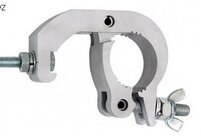

Can you get the keyless chuck tight enough for the forstner bits?I have one of these and it works well. Inexpensive too.
The shafts are hexagonal going in to the drill chuck on my forstner bits. If the chuck can’t hold hex bits then, IMO, it’s time to buy a new chuck.
Drill it out with a small bit and then switch to hollow tools. Then you don’t have to worry about cheap bits, cheap chucks, and slippage.Recommendations sought for holding forstner bits while drilling out vases? Any thoughts appreciated, THANKS.
I have this 1/2" keyless chuck and use it with hexagonal and smooth shaft forstner bits for boring ... appears to be on sale at the moment .... works great.
Mark Hepburn
Artist & Chef
Can you get the keyless chuck tight enough for the forstner bits?
Yes, I haven't had a problem with it so far. I've used Forstner bits for Crushgrind pepper mills but nothing larger (about 1 1/8 as I recall)
I just recently watched a demo on peppermills. The presenter was using something like this:https://infinitytools.com/products/...ex-shank-forstner-bits?variant=46847655182625
I looked that up and it showed me a #1 morse taper keyed chuck and said it could be used with a 1/4-20 draw bolt, then said it couldn't be used with a draw bar seems like some confusion going on and nothing was said about a hole for a pin.See Packard Woodworks catalog, Item number 111011, Arbor key chuck. I have a YouTube video on how to secure it in the tailstock for drilling. I put a pin in it to prevent it from coming out f the quill when pulling the drill out.
I would buy a tapered chuck that takes a draw bar if you plan on doing a lot of heavy drilling.
I was finally successful in drilling out this vase with a forstner bit but I should have been provided full disclosure when I asked my initial question...the forstner bit is 2 1/4 inches.
Second question...does anyone drill out their vases first on the drill press before mounting the blank on the lathe?
Second question...does anyone drill out their vases first on the drill press before mounting the blank on the lathe?
About the time you get the chuck tight enough to keep the bit from spinning the MT of the chuck spins in the tailstock. An old machinist's trick is to clamp a lathe dog to the drill bit shank and it in turn rides on the (in woodturning) tool rest.
I do most heavy drilling on the drill press with either a keyed or keyless chuck - they both hold equally well. Forstner bits with hex shafts work even better with even casual tightening since there is no way they can slip.
For Forstner bits that have round 3/8" shafts, I've moved to end mill holders that fit into the tailstock. These are quite precise. They have a large set screw to keep the bit snug.
There is the potential for spinning in the taper if drilling aggressively but I solve that by holding the holder with pliers while drilling. It will take a 3/8x16 drawbar but that's only practical when held in the headstock.
I think this one is a 2-1/8 for drilling a recess for 50mm chuck jaws. (I used drill a recess in the upper side of bowl or platter to hold in a chuck while turning the bottom. These days I use a simpler method for that - a Glaser screw chuck.)
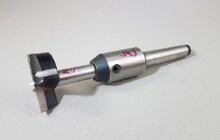
Years ago I came up with something else when drilling deep hols with Forstner bits, for example when drilling pepper mills. While drilling, I direct a continuous strong stream of compressed air into the hole at the back of the bit. This does two things: keeps the chips clear which can let the bit cut better, and related to that, keeps the bit and wood cooler.
Hey, while on the topic of drilling, for smaller holes I've moved mostly to taper shank bits. Far quicker, more precise, no Jacob's chuck needed.

They also allow drilling small diameter holes without the risk of vibration reducing the precision since the total length from the tailstock is much shorter.
Most taper shank bits are #2MT but the smaller bits are #1MT and need an adapter. I learned about these long time ago from Rudy Lopez; have them in almost every common diameter now.
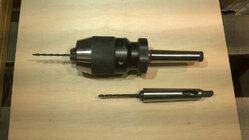
JKJ
For Forstner bits that have round 3/8" shafts, I've moved to end mill holders that fit into the tailstock. These are quite precise. They have a large set screw to keep the bit snug.
There is the potential for spinning in the taper if drilling aggressively but I solve that by holding the holder with pliers while drilling. It will take a 3/8x16 drawbar but that's only practical when held in the headstock.
I think this one is a 2-1/8 for drilling a recess for 50mm chuck jaws. (I used drill a recess in the upper side of bowl or platter to hold in a chuck while turning the bottom. These days I use a simpler method for that - a Glaser screw chuck.)

Years ago I came up with something else when drilling deep hols with Forstner bits, for example when drilling pepper mills. While drilling, I direct a continuous strong stream of compressed air into the hole at the back of the bit. This does two things: keeps the chips clear which can let the bit cut better, and related to that, keeps the bit and wood cooler.
Hey, while on the topic of drilling, for smaller holes I've moved mostly to taper shank bits. Far quicker, more precise, no Jacob's chuck needed.

They also allow drilling small diameter holes without the risk of vibration reducing the precision since the total length from the tailstock is much shorter.
Most taper shank bits are #2MT but the smaller bits are #1MT and need an adapter. I learned about these long time ago from Rudy Lopez; have them in almost every common diameter now.

JKJ
Even for pieces that will have a large opening, I use a 1-1/8” forstner to drill to ~2” depth, then use a 1-1/8” auger to go deeper. Widen the opening with by back hollowing with a spindle gouge, then use a Jamieson hollowing system.I was finally successful in drilling out this vase with a forstner bit but I should have been provided full disclosure when I asked my initial question...the forstner bit is 2 1/4 inches.
Second question...does anyone drill out their vases first on the drill press before mounting the blank on the lathe?
Most of my vases don’t go much beyond the 1-1/8”, which is clearance for the swivel cutter used by the hollowing system.
large forstner bits are a pita, and I find drilling deep with auger bits (dont have to be backed out to clear chips) more efficient vs forstner.
Yes, I use this one. Works perfectly with both round and hexagonal shafted forstner bits. . And I have extenders to get the bit deeper when I'm doing taller vases.Recommendations sought for holding forstner bits while drilling out vases? Any thoughts appreciated, THANKS.
Roger Wiegand
Beta Tester
Huge fan of drill bits with #2 MT shanks! I'm gradually filling out a set at a buck a piece from the used tool store. He seems to get a batch every couple of months, the trick is to get there before all that's left are the 17/64ths one.
With a bit of hunting I've outfitted both the lathe and DP with used Albrecht keyless chucks for a reasonable price. They are really wonderful to use. No more banged up drill shanks from cheap chucks.
With a bit of hunting I've outfitted both the lathe and DP with used Albrecht keyless chucks for a reasonable price. They are really wonderful to use. No more banged up drill shanks from cheap chucks.
Doing so would tend to loosen a keyless chuck if clamped on the sleeve. It would be necessary to clamp on the chuck body.I use this with a MT2 keyless chuck and 3-1/2" forstner bit. I put the chuck in the clamp and let the arm slide back and forth over the tool rest. Clamp info
View attachment 81475
Tim
In my experience drilling a hole with a 2 1/4" Forstner has been too big an ask. Either the bit will spin in the chuck, or worse, the chuck will spin in the Morse taper. Much over 1" I step up to the final Forstner, for example 1" > 1 3/4" > 2 1/4". Admittedly, the bits I'm using may not be the best quality, but they're the bits I have.I was finally successful in drilling out this vase with a forstner bit but I should have been provided full disclosure when I asked my initial question...the forstner bit is 2 1/4 inches.
Second question...does anyone drill out their vases first on the drill press before mounting the blank on the lathe?
If you're choosing a chuck, a 5/8" chuck will have a better hold on a 1/2" shank, then will a 1/2" chuck.
I have pre-drilled holes on the drill press, when the work flow permits. The same suggestion about drilling small to final size applies.
For a hole of that size, unless you're in production mode, why not turn a hole as you would for a box? You could start with a depth hole of a diameter that your set up can manage, and open it up quickly and easily.I was finally successful in drilling out this vase with a forstner bit but I should have been provided full disclosure when I asked my initial question...the forstner bit is 2 1/4 inches.
Either the bit will spin in the chuck, or worse, the chuck will spin in the Morse taper.
If anything spins, I hold it, either with pliers of some sort or by steel rods that holes built into some of my chucks.
One thing - when I drill with large forstners I use carbide bits - they don't cut as smooth as HSS but sure cut faster and the smoothness is often not needed.
About the time you get the chuck tight enough to keep the bit from spinning the MT of the chuck spins in the tailstock. An old machinist's trick is to clamp a lathe dog to the drill bit shank and it in turn rides on the (in woodturning) tool rest.
What is a lathe dog? Not familiar with that device. thanks...j
A lathe dog little devise used in metal turning lathes. It clamps on a shaft, usually round, with a bolt and has a protrusion opposite the bolt that is driven by the lathe at the headstock. Since precision cylinders, shafts, and such are normally turned while held between two conical centers (seated in 60-deg conical depressions), the lathe dog is what spins the cylinder. The cylinder can be mounted in a driven by a 3 or 4-jaw chuck as with woodturning, but these can be imprecise or difficult to set up, and like wood, once a piece is removed from the chuck it may not be possible to remount it for further work. The method used in the metal lathe solves this problem.What is a lathe dog? Not familiar with that device. thanks...j
This is a lathe dog:

Here's one in use on the metal lathe, driven by one chuck jaw.
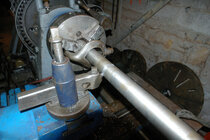
I find even a small metal lathe and mill a nice complement to woodturning - can do, make, repair, and modify things including tools, lathe parts, jigs, etc. Need a specialized bolt, bushing, tool handle insert, just make it! While I often make inserts for handles on the wood lathe from aluminum, it was a lot quicker to make this one from brass on the metal lathe since it was large (took a 5/8" tool shaft. Handle is persimmon.
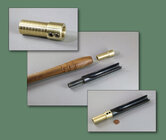
JKJ
It’s common to drive a lathe dog with a slot in a faceplate (typically an open-ended slot).
Tim
Tim
This is how a lathe dog is used for drilling in a wood lathe. Can also be used in similar manner on a metal lathe. Your lathe motor will stall out before a drill bit or the MT slips when doing it this way. I only use it for production work or in extreme cases. My normal chucks are either a Jacobs Super Chuck (pictured) or a Albrecht keyless which I consider the best made, but a bit has slipped on occasion in both.


large forstner bits are a pita, and I find drilling deep with auger bits (dont have to be backed out to clear chips) more efficient vs forstner.
@Doug Freeman, you might have missed it or maybe tried and it didn't work for you, but as I wrote earlier when drilling with large Forstner bits on the lathe I always use a method which eliminates a buildup of chips and usually the need to periodically back out the bit. It does, of course, require an air compressor:
"Years ago I came up with something else when drilling deep holes with Forstner bits, for example when drilling pepper mills. While drilling, I direct a continuous strong stream of compressed air into the hole at the back of the bit. This does two things: keeps the chips clear which can let the bit cut better, and related to that, keeps the bit and wood cooler."
I use an air gun with a fairly long cylindrical nozzle which directs the air better in the hole. I'm running about 90 psi from a large compressor. A wimpy air stream might not work as well.
Also, for deep holes that don't need to have perfectly smooth sides, say for removing wood for turning inside, I do not use the good HSS bits but the "coarse" carbide bits. These don't cut nearly as smooth a hole but drill far quicker. The difference is significant. Note the outside, instead of having a continuous circumference of saw teeth, has just two points to score a circle on the wood and two flat cutters which chisel out the wood inside that circle. These are still sharp after a lot of use.

I've demonstrated the my compressor method and have gained a few converts. Yay!
I keep sets of both carbide and HSS continental (Inch size) Forstner bits on hand and separate sets of smaller metric. In a weak moment a few decades ago the owner of a retail store sold me these sets at cost. I didn't protest. I feel so ashamed. (Actually she said they sat on the shelf for a while and she was tired of looking at them.)
JKJ
